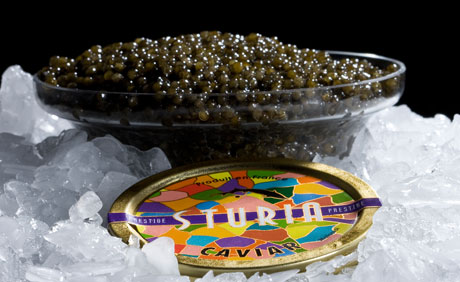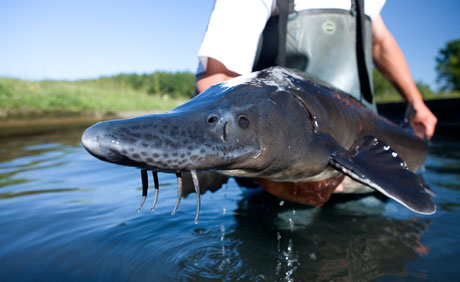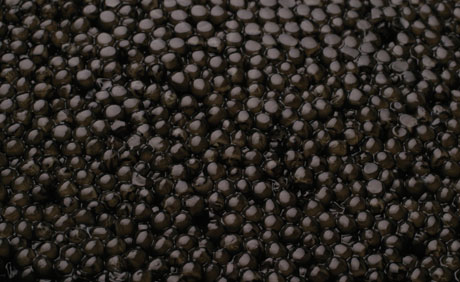From the famous caviar of the Caspian Sea to today’s sustainable production, the eggs of the sturgeon remain one of the most prized gourmet products in the world.
Noted as one of most prized gourmet products in the world, caviar should not be eaten but simply tasted and if possible, enjoyed. Purists argue that it should always consumed plain, fresh and when possible accompanied by toast and champagne. The presence of caviar in gastronomy is transversal to its use in the kitchen by experienced master chefs, who consider it to be one of the most beloved and mythical delicacies out there.
These small balls with a sea flavour and freshness unmatched are, after all, unfertilized eggs from one of the largest fish in the world, the sturgeon which is subjected to a special process that gives them the taste and the quality. It can be tasted as an appetiser or canapé, where it takes centre stage, or as an accompaniment to the most extravagant of dishes. It is always a sensory pleasure for the gourmet as the eggs burst in the mouth, releasing their unique flavour.
The wonders of caviar have always been recognized yet it was at the court of the Russian Czars in the sixteenth century that it became an object of desire and disseminated by European courts. Its popularity grew in the United States during the early nineteenth century, when emigrants found an abundance of sturgeon in the rivers.
It was so plentiful, in fact, that bars and saloons would serve small plates of caviar free of charge, hoping that its saltiness would increase beer sales! But this abundance was short-lived, as resourceful immigrants started to export the caviar to Europe, soon depleting sturgeon stocks in America’s rivers.
In France, after the First World War and under much influence from the Russian aristocrat refugees, who fled from the Bolshevik revolution and chefs who worked in Russia, caviar definitely entered into the world of haute cuisine.
Arguably, the finest and undoubtedly the most expensive caviar in the world remains that of the Caspian Sea from the Beluga sturgeon. For centuries, Russia and Iran dominated the market, but today, wild caviar production from the Caspian sea survives only in Iran and Azerbaijan since Russia introduced a self-imposed ban on the fishing of wild Caspian sturgeon, hoping to save the species from extinction.
With the depletion of wild sturgeon stocks around the world, most of the caviar consumed today is from farmed fish, the most famous of which come from Aquitaine in southern France.
The Gironde estuary, in France, also contains another species of sturgeon (Acipenser sturio) from which caviar was produced. Legend has it that a travelling Russian princess noticed that fishermen consumed only the fish and not the eggs from the sturgeon. As a caviar connoisseur, she advised them to consume the eggs instead of throwing them back into the sea.
Legend or fact, the Aquitaine sturgeon is now a protected species. It was in this same region that French company Sturia began producing caviar through aquaculture.
This company is involved in an environmental project of the recovery of the Aquitaine sturgeon, and produces about 13 tons of caviar annually, which is further exported to countries worldwide, including Portugal and especially Madeira.
Geraldine Grall, representative for the Portuguese market, explains to Essential that Sturia produces caviar from two species of sturgeon. On the one hand, the Sibeirian (Acipenser baerii) which is responsible for most of the production and on the other, the Russian sturgeon (Acipenser gueldenstaedtii) which is used for the Ossetra caviar, as yet only available on the French market. The company is also making progress in the creation of white sturgeon (Huso huso), from which is produced the famous Beluga caviar, the King of all Caviars.
Whilst in Madeira, Geraldine Grall organized a tasting session for Michelin star chefs such as Benôit Sinthon (Il Gallo D'Oro), Vítor de Matos (Casa da Calçada), the French Serge Goulomès and David Faure, among others.
This tasting session was carried out with different types of caviar, all from the Siberian sturgeon, ranging in texture, colour and berry size. Geraldine Grall explains that “it is important to know that the maturation stage provides the caviar with a different taste.” Sturia´s main clientele is comprised of chefs that contribute with their expertise, towards “defining the selection criteria”. For best flavor, caviar should be consumed shortly after the opening of the jar, stored at a temperature ranging from -3 to 3 degrees, and kept in crushed ice.
Sturia caviar contains approximately 4% of salt, following the main criteria used by worldwide producers. Geraldine Grall stresses that “a clean palate” is preferable in order to enhance one´s tasting experience with caviar, “which has a specific and somewhat peculiar taste.”
Geraldine Grall also refers to the “different ways of consuming caviar”, referring mainly to the following: “on a spoon the client must make the berries rotate in the mouth and crush them against the palate in order to retrieve all flavours.” The initial flavour stems from the saltiness of the caviar which soon evens out into a unique gourmet experience of combined flavours and textures!

















